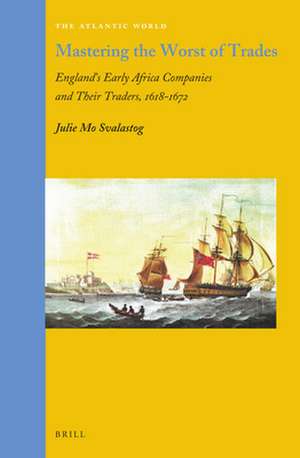Mastering the Worst of Trades: England’s Early Africa Companies and their Traders, 1618–1672: The Atlantic World, cartea 39
Autor Julie M. Svalastogen Limba Engleză Hardback – 17 feb 2021
Din seria The Atlantic World
- 18%
 Preț: 684.27 lei
Preț: 684.27 lei - 18%
 Preț: 723.26 lei
Preț: 723.26 lei - 18%
 Preț: 722.26 lei
Preț: 722.26 lei - 18%
 Preț: 721.01 lei
Preț: 721.01 lei - 18%
 Preț: 721.10 lei
Preț: 721.10 lei - 18%
 Preț: 728.86 lei
Preț: 728.86 lei - 18%
 Preț: 719.53 lei
Preț: 719.53 lei - 18%
 Preț: 551.72 lei
Preț: 551.72 lei - 18%
 Preț: 1142.35 lei
Preț: 1142.35 lei - 18%
 Preț: 718.37 lei
Preț: 718.37 lei - 18%
 Preț: 680.40 lei
Preț: 680.40 lei - 18%
 Preț: 524.15 lei
Preț: 524.15 lei - 18%
 Preț: 687.25 lei
Preț: 687.25 lei - 18%
 Preț: 684.15 lei
Preț: 684.15 lei - 18%
 Preț: 665.54 lei
Preț: 665.54 lei - 18%
 Preț: 843.41 lei
Preț: 843.41 lei - 18%
 Preț: 1259.78 lei
Preț: 1259.78 lei - 18%
 Preț: 844.28 lei
Preț: 844.28 lei - 18%
 Preț: 684.64 lei
Preț: 684.64 lei - 18%
 Preț: 832.07 lei
Preț: 832.07 lei - 18%
 Preț: 717.59 lei
Preț: 717.59 lei - 18%
 Preț: 581.88 lei
Preț: 581.88 lei - 18%
 Preț: 687.47 lei
Preț: 687.47 lei - 15%
 Preț: 459.18 lei
Preț: 459.18 lei - 18%
 Preț: 629.37 lei
Preț: 629.37 lei - 18%
 Preț: 726.69 lei
Preț: 726.69 lei - 18%
 Preț: 636.54 lei
Preț: 636.54 lei - 18%
 Preț: 692.48 lei
Preț: 692.48 lei - 18%
 Preț: 595.58 lei
Preț: 595.58 lei - 18%
 Preț: 680.69 lei
Preț: 680.69 lei - 18%
 Preț: 551.08 lei
Preț: 551.08 lei - 18%
 Preț: 681.46 lei
Preț: 681.46 lei - 18%
 Preț: 678.05 lei
Preț: 678.05 lei - 18%
 Preț: 678.83 lei
Preț: 678.83 lei - 18%
 Preț: 680.99 lei
Preț: 680.99 lei - 18%
 Preț: 678.44 lei
Preț: 678.44 lei
Preț: 620.31 lei
Preț vechi: 756.47 lei
-18% Nou
Puncte Express: 930
Preț estimativ în valută:
118.69€ • 123.93$ • 98.24£
118.69€ • 123.93$ • 98.24£
Carte indisponibilă temporar
Doresc să fiu notificat când acest titlu va fi disponibil:
Se trimite...
Preluare comenzi: 021 569.72.76
Specificații
ISBN-13: 9789004440821
ISBN-10: 9004440828
Dimensiuni: 155 x 235 mm
Greutate: 0 kg
Editura: Brill
Colecția Brill
Seria The Atlantic World
ISBN-10: 9004440828
Dimensiuni: 155 x 235 mm
Greutate: 0 kg
Editura: Brill
Colecția Brill
Seria The Atlantic World
Cuprins
Acknowledgments
List of Illustrations and Tables
Abbreviations
Introduction
Foundations
1 Launching the Guinea Company, 1618–1630
1 Introduction
2 Members of the Early Guinea Company
2.1Discoverers and Naval Men
2.2Court Connections and Financial Trouble
3 The Two Merchants
3.1John Davies
3.2Humphrey Slaney
4 The Company in Court
5 Internal Strife
6 The End of the First Patent
7 Conclusion
2 Fit for Purpose: the Guinea Company in the 1630s and 1640s
1 Introduction
2 Format of Trade
3 John Wood and the Guinea Company of the 1640s
4 A 1640s Snapshot
5 Early English Slave Trade – Formal and Informal
6 Conclusion
3 The Honourable Guinea and East India Company, 1640–1663
1 Introduction
2 Why the Coast of Guinea?
3 Potential for Connection
4 Renegotiating the Patent
4.1Samuel Vassal’s Suggestions and Changes in to the Patent
4.2An Unfortunate Gambian Adventure
4.3Gold Mining
5 1657 to 1664: the United East India and Guinea Company on the Coast of Africa
6 The Loss of the Trade
7 Conclusion
4 The Official Push to the West: How to Control the Atlantic?
1 Introduction
2 Practices of the Past, the Case of Virginia
3 The English Civil War
4 A New approach to Colonial Management
5 The Restoration
6 Conclusion
5 Royal Adventurers and the Spanish Asiento
1 Introduction
2 The Company of Royal Adventures Trading into Africa
3 Securing the Asiento
4 Servicing the Asiento
5 English Slave Trading under the Asiento
6 Winding up the company
7 Conclusion
Conclusion
Appendix 1 Africa Company Members
Appendix 2 Debtors to the Guinea Company from June 1643 to June 1644
Primary Archival Material
Bibliography
Index
List of Illustrations and Tables
Abbreviations
Introduction
Foundations
1 Launching the Guinea Company, 1618–1630
1 Introduction
2 Members of the Early Guinea Company
2.1Discoverers and Naval Men
2.2Court Connections and Financial Trouble
3 The Two Merchants
3.1John Davies
3.2Humphrey Slaney
4 The Company in Court
5 Internal Strife
6 The End of the First Patent
7 Conclusion
2 Fit for Purpose: the Guinea Company in the 1630s and 1640s
1 Introduction
2 Format of Trade
3 John Wood and the Guinea Company of the 1640s
4 A 1640s Snapshot
5 Early English Slave Trade – Formal and Informal
6 Conclusion
3 The Honourable Guinea and East India Company, 1640–1663
1 Introduction
2 Why the Coast of Guinea?
3 Potential for Connection
4 Renegotiating the Patent
4.1Samuel Vassal’s Suggestions and Changes in to the Patent
4.2An Unfortunate Gambian Adventure
4.3Gold Mining
5 1657 to 1664: the United East India and Guinea Company on the Coast of Africa
6 The Loss of the Trade
7 Conclusion
4 The Official Push to the West: How to Control the Atlantic?
1 Introduction
2 Practices of the Past, the Case of Virginia
3 The English Civil War
4 A New approach to Colonial Management
5 The Restoration
6 Conclusion
5 Royal Adventurers and the Spanish Asiento
1 Introduction
2 The Company of Royal Adventures Trading into Africa
3 Securing the Asiento
4 Servicing the Asiento
5 English Slave Trading under the Asiento
6 Winding up the company
7 Conclusion
Conclusion
Appendix 1 Africa Company Members
Appendix 2 Debtors to the Guinea Company from June 1643 to June 1644
Primary Archival Material
Bibliography
Index
Notă biografică
Julie M. Svalastog completed her Ph.D. as researcher in the ERC funded project Fighting Monopolies, Defying Empires 1500–1750 based at Leiden University, the Netherlands. Her work there focused on the early modern English expansion.
